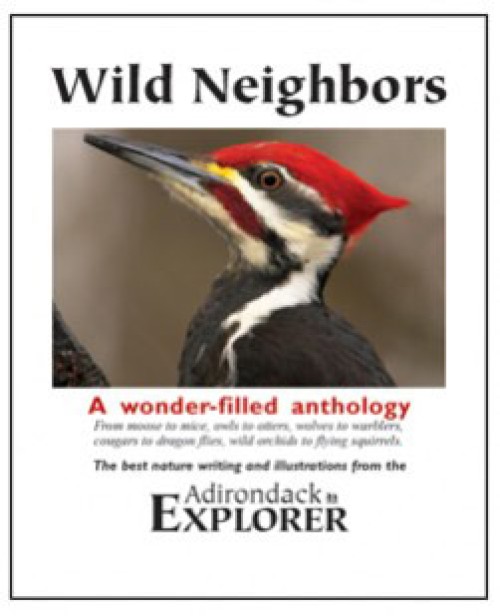by Edited by Dick Beamish
Adirondack Explorer, 2007
Perhaps the most striking thing you first notice about the book Wild Neighbors (besides the stunning, full color, close-up portrait of a pileated woodpecker that graces the cover) is its size. The large-format, softbound “book” measures 11 x 13½ inches, and it looks and feels more like an oversize magazine. Which is fitting since this collection of natural history articles was previously published in the bi-monthly magazine, the Adirondack Explorer, between 1998 and 2007. The 80 or so articles are grouped together taxonomically – mammals, birds, reptiles, amphibians, and insects – with mammals and birds accounting for nearly 100 of the book’s 110 pages that are devoted to the essays. The final eight pages introduce the reader to various resources about the Adirondacks, including several books by authors who contributed to the anthology.
The collection includes essays by 25 different authors, including Curt Stager, Edward Kanze, Willem Lange, and Alan Pistorius – names that anyone in the Northeast who enjoys natural history writing should be familiar with. Pistorius penned the lion’s share of the 50 pages on birds, a topic on which he is well-versed, articulate, and entertaining. Yet rediscovering Ed Kanze’s writing after many years was a most welcome experience. Years ago, I lived in southern New England where Kanze wrote a weekly nature column for my local paper. I looked forward to his work every week. His writing is fluid, inviting, and entertaining, yet full of sound science and careful observations. One of my favorite essays in the collection is Kanze’s “Diary of a Mad Snapper,” a series of first-person journal entries, written from a snapping turtle’s perspective, that describe the last few weeks of autumn leading up to hibernation.
While the majority of the essays are natural history pieces, there are a few point-counterpoint articles that present both sides of an issue as well. For example, in response to the question, “Should the state control Champlain cormorants?”, University of Vermont biology professor Dave Capen presents his views in support of such a program, while John M. C. Peterson, a well-known birder and wildlife manager of a Lake Champlain bird sanctuary, offers the counterpoint.
The book is illustrated with a mix of photographs, line drawings, and cartoons that nicely support the prose. The black-and-white photos, many of which are of very high quality, come from a host of local wildlife photographers, including Gerry Lemmo, Jeff Nadler, Gary Randorf, Marie Read, and others. The detailed line drawings were done by Mike Storey, while the light-hearted cartoons were provided by Jerry Russell.
While the writing is excellent and features a wealth of up-to-date information that any nature lover would enjoy, I can’t quite get past the presentation. Despite its full-color, glossy cover, the inside is printed on newsprint, and the “atlas size” format is clumsy and difficult to put on a night stand, bookshelf, or to carry along on a trip. Also, I would have welcomed biographical information about the authors. Despite these shortcomings, Wild Neighbors: A Window on Adirondack Wildlife is a fine collection of natural history writing that will appeal to many well beyond the borders of the Adirondack Park.
Available directly from the publisher, Adirondack Explorer.


